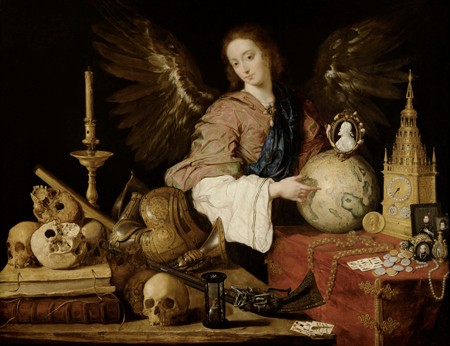In an oil painting by the Spanish artist Antonio de Pereda y Salgado
(c. 1611–1678) completed in 1634, two tables strewn with objects from the vanitas tradition appear bathed in warm light. The ephemeral effects of this illumination serve to underscore the symbolic charge these objects carried for contemporary viewers, reminders of the fleeting nature of the material world and the impending reality of death. Among the canonical imagery of skulls, playing cards, coins, a clock, a candle, and an hourglass, the unusual textile worn by the painting’s enigmatic central figure stands out both for its novelty in this context and for its colors. Through the careful manipulation of icy pinks and mint greens, Pereda has attempted to capture the visual effects of shot fabric, a type of iridescent textile whose colors appear to shift depending upon the angle of view. What led the artist to choose this fabric specifically as an element of his painting, and how might his audience have interpreted its presence?
During my year at CASVA, I have proposed answers to these and related questions that address the reception of iridescent materials in the early modern Hispanic world, a line of inquiry that forms the core of my dissertation. In it, I examine historical reactions to such materials in order to address the relationship
Why were early modern viewers in Spain and Mexico—and beyond—so fascinated with iridescence? Color is a fundamental aspect of visual perception. Objects within our field of vision are identified and defined in part through their hue, a quality that appears to be inherent to them. Iridescent materials challenge the idea that colors are properties of the things that we see because of the visual experience they provide, in which shifts in viewing geometry yield contrasting optical data. Early modern naturalists, philosophers, playwrights, missionaries, artistic theorists, collectors, and patrons engaged with iridescence because it provoked epistemological questions regarding the veridicality of sense data.
The study of these materials is especially relevant within the context of the early modern Hispanic world. First, the geographical parameters of the Spanish empire facilitated the circulation of iridescent natural materials to which neither Europeans nor Central Mexicans had had previous access. Second, Iberian expansion to the Americas brought with it a rich and heterogeneous lineage of thought on iridescent materials, a system of ideas that was matched in complexity by those of the indigenous inhabitants of the region. This context not only allows for a comparison of
